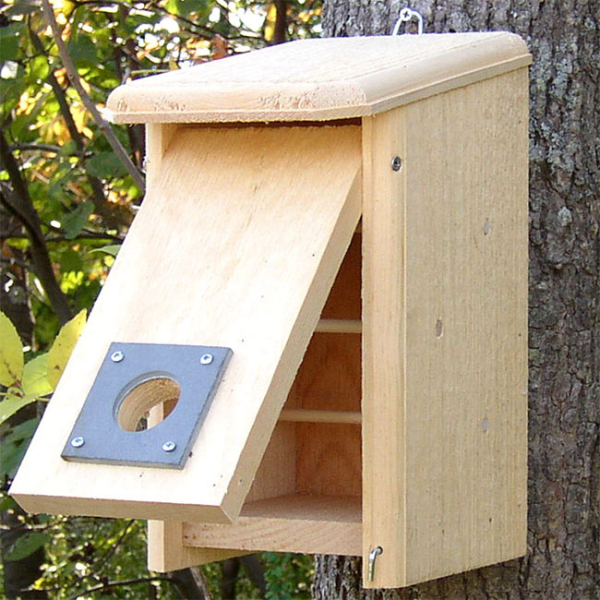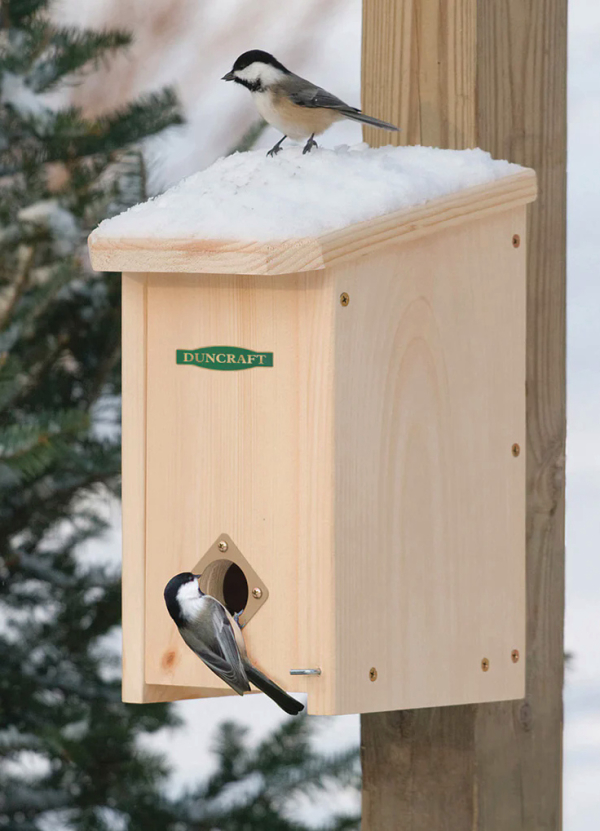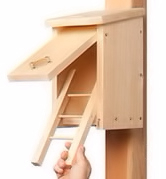
A reversed Convertible Roost–Nest Box with the entrance positioned at the bottom of the box can benefit some birds during harsh late fall and winter weather periods.

Black-capped Chickadees are among the cavity nesting birds that will use a Convertible Roost–Nest Box during winter – and during spring when the nesting season begins.

Installing a perch in a reversed Convertible Roost–Nest Box with the entrance hole positioned at the bottom of the box for winter roosting.
|
Some cavity nesting birds will use a nest box as a roosting location overnight and during inclement weather during late fall and winter. This is especially true for small owls and woodpeckers, and some cavity nesting songbirds like bluebirds and chickadees. Better yet though, are “Convertible Boxes” that can be used as a roost box during fall and winter, and as a nest box during spring and summer – and they are becoming big hits among birders. They are truly real 2-in-1 birding products that can benefit birds year-round.
Having a screech owl roosting in your yard is a pretty special experience – one to encourage – although having bluebirds or chickadees roosting in a convertible roost-nest box is hard to beat too. But it’s not just about our thrills, it’s especially about providing the kinds of applications that will benefit birds, and that’s where a roost box comes in. But let’s get beyond even a roosting box, and emphasize the optional use of a Convertible Roost–Nest Box, which can now be considered the best bet for winter and nesting seasons.
So what’s a Convertible Roost–Nest Box? Essentially, it’s a nest box that allows you to reposition the front panel of the box with the entrance hole positioned at the bottom of the box during fall and winter, when it’s a roost box. In that position, the interior of the box retains warm air better, as the warmer air generated by the birds rises and stays inside the box. During the roosting season, temporary perches are also installed inside the convertible box so the bird or birds can perch above the entrance level.
Then, in advance of the nesting season, you remove the perches and reverse the front panel so the entrance hole is positioned at the top of the box. In that way, the nest, eggs, nestlings, and incubating birds are positioned at the bottom of the box, out of reach of mammalian predators.
We are only aware of 2 models of Convertible Roost–Nest Boxes on the market now, both made for cavity-nesting songbirds including bluebirds and chickadees. These are available from BestNest at Coveside Convertible Bird House/Winter Roost at BestNest.com and Duncraft at Duncraft Convertible Roost House
You Can Convert a Nest Box Too
Convertible Roost–Nest Boxes are a great idea that is just starting to catch on, but it’s a relatively easy modification to convert any nest box into one with a reversible entrance. For example, modifying a nest box into a reversible roost–nest box can be especially useful if you are looking to attract one of the small owls – screech, saw-whet, pygmy, or Boreal Owls – or even larger Barn Owls. Just remove the screws or nails that attach the front panel to the rest of a nest box you already have in your yard or another property. Flip the front panel upside down, and screw it into place. (We suggest reinstalling with screws, which should make taking them out and reinstalling them a bit easier.) Once you have done this once, you may find an easier or better way to make the flip, but for now, you get the idea – give it a try. A removable perch of some kind is also needed during the roosting period, but adding that should be an easy task too.
Just as with nest boxes, it may take a while, or a season or 2 for a bird or birds to occupy a roost box, so patience is always a virtue, and the payoff is that you have both a roost box AND a nest box all in one. Give it a try and good luck!
Share your backyard birding experiences and photos with The Birding Wire at editorstbw2@gmail.com